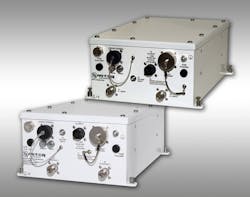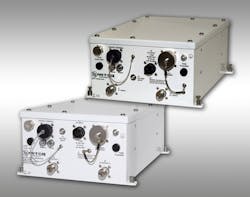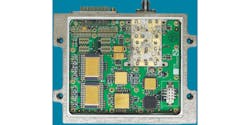Replace Components With A Single Module
Systems, such as receivers, are often designed as a block diagram that combines multiple component-level functions—e.g., a frequency mixer, a local oscillator (LO), and filters. When it is time to build the hardware system, such components are available from a large number of RF/microwave suppliers and in many different types of packages, allowing engineers to assemble a system design from practical components.
Related Articles
• Passive Components Pack More Power
• Components Help Satcom Systems Fly
• Components Aid Broadband Testing
But when the need arises to squeeze a bit more system-level performance from a smaller package, many components suppliers can also provide standard and custom integrated microwave assemblies (IMAs). This makes it possible to construct a system from a smaller number of larger multifunction modules—one than often boasts size, weight, and performance advantages compared to what can be achieved by combining discrete RF/microwave components.
In many cases an IMA—or microwave integrated circuit (MIC), as it has been traditionally known—appears to resemble small systems (Fig. 1) housed within a rugged enclosure for protection and isolation. Many IMAs integrate different technologies as well as components, often blending DC circuitry with higher-frequency analog components and digital signal-processing functionality. As an example, Phase Matrix created a 9-to-15-GHz digitally tuned oscillator module by combining the outputs of multiple signal sources by means of Wilkinson power combiners (Fig. 2).
1. These compact modules are actually block frequency converters for satellite-communications (satcom) systems, helping to simplify either upconversion or downconversion. (Photo courtesy of MITEQ, Inc.)
2. This printed-circuit-board (PCB) multifunction module combines several oscillators and amplifiers to achieve high output levels across a wide frequency range with digital control built in. (Photo courtesy of Phase Matrix.)
GaAs MMIC amplifiers are used to maintain a required output level and tuning is by means of transistor-transistor-logic (TTL) control. The module also contains components not typically found in RF/microwave components, including electronically erasable programmable read-only memory (EEPROM) and a digital-to-analog converter DAC). The hermetic source adjusts by means of 12-b tuning and delivers 15-dBm output power with low noise across a temperature range of -40 to +85°C.
Targeting Commercial Markets
Although IMAs or MICs are often associated with military applications, some companies have coupled components together in assemblies for commercial markets with larger volumes. One such firm is MITEQ, which claims lines of multiple-input block upconverter and downconverter modules for Ku- and Ka-band satellite-communications (satcom) systems. Not only do the converter modules help simplify system layout, they also improve system performance. One of the multiple-input converter modules can combine two or three independent outdoor frequency converters into one antenna-mount package. In the case of an upconverter, two or three intermediate-frequency (IF) input signals are converted into a single wideband RF output signal to feed an output amplifier and antenna.
In another case, a company often associated with integrated-circuit (IC) components, Hittite Microwave Corp., has developed a series of in-phase/quadrature (I/Q) frequency upconverter and downconverter modules for use in 38- and 42-GHz microwave radios. The firm’s models HMC6787ALC5A and HMC6146BLC5A are GaAs monolithic-microwave-integrated-circuit (MMIC) variable-gain I/Q frequency upconverters. They are used for building cost-effective microwave radio transmitters at 38 and 42 GHz, respectively.
Model HMC6787ALC5A operates from 37 to 40 GHz with 10-dB small-signal conversion gain, -17-dBc sideband rejection, and 13-dB gain control. The model HMC6146BLC5A MMIC runs from 40 to 44 GHz with 12-dB small-signal conversion gain, -25-dBc sideband rejection, and 17-dB gain-control range. The I/Q upconverters both deliver +27-dBm third-order intercept point (IP3), and both meet the requirements of VSAT/satcom transmitter terminals covering the EHF frequency band. In contrast to some of the military-grade modules, however, these multifunction units are the size of components, supplied in RoHS-compliant surface-mount-technology (SMT) packages measuring just 5 x 5 mm.
Companies with impressive capabilities in designing and manufacturing IMAs have typically already demonstrated those skills at the component level, although more complex tools are typically needed to support the creation of effective IMA solutions. Narda Microwave, for example, can move easily between building single-function components and multifunction modules because of their capabilities in testing both types of products.
The firm’s extensive test equipment includes microwave vector network analyzers (VNAs) operating through 65 GHz, high-power test capability through 18 GHz, spectrum analyzers through 50 GHz, oscilloscopes through 50 GHz, phase-noise measurements through 26 GHz, and even fiber-optic bit-error-rate (BER) testers capable of measuring rates to 2.67 Gb/s. The firm also leverages extensive computer-aided-engineering (CAE) software tools, including system-level simulations, high-frequency structure simulator (HFSS) electromagnetic (EM) modeling software, and mechanical computer-aided-design (CAD) software.
Related Articles
• Passive Components Pack More Power
• Components Help Satcom Systems Fly
• Components Aid Broadband Testing
Understanding the importance of test to the development of reliable IMAs, Anaren has built an arsenal of environmental test gear, including equipment for evaluating the performance of components and IMAs under shock, vibration, salt fog, humidity, and with thermal cycling. The company, which has honed the skills of its microelectronics assembly personnel to achieve true “built-to-print” capabilities in order to realize complex circuit configurations from customers, has worked with a variety of different circuit building-block materials, including low-temperature-cofired-ceramic (LTCC) and multilayer thick-film materials, to achieve a large number of functions within small package sizes.
Mercury Systems Ltd. has also worked with a variety of different circuit materials in creating its IMAs, including LTCC, soft circuit boards (such as Teflon), and alumina substrates. As with MITEQ, Narda, and many other IMA suppliers, Mercury has found the needs of the satcom market to be strong, especially for the gains in size and performance possible through integration of multiple functions into a single module. In addition to the RF/microwave circuitry, the firm also handles digital and DC circuitry within the modules, many of which are custom designs closely guided by a customer’s requirements.
About the Author
Jack Browne
Technical Contributor
Jack Browne, Technical Contributor, has worked in technical publishing for over 30 years. He managed the content and production of three technical journals while at the American Institute of Physics, including Medical Physics and the Journal of Vacuum Science & Technology. He has been a Publisher and Editor for Penton Media, started the firm’s Wireless Symposium & Exhibition trade show in 1993, and currently serves as Technical Contributor for that company's Microwaves & RF magazine. Browne, who holds a BS in Mathematics from City College of New York and BA degrees in English and Philosophy from Fordham University, is a member of the IEEE.


